While most caterpillars are completely harmless to humans, some of them can sting. While the sting might not be health-threatening to humans, it can still be irritating.
There are some caterpillars that even cause urticaria or days of lasting sting pain.
Learning to stay away from stinging species is crucial as they should not be handled directly.
Table of Contents
How Can Caterpillars Sting
Stinging caterpillars are known for their stinging hairs. These are coarse hairs connected to venom glands or sacs as they’re hollow.
The hairs are sharp and can pierce the skin which allows the poison to escape and start urticating.
The number of hairs as well as the concentration of toxins differs from one stinging caterpillar to another.
Erucism is the term that encompasses envenomation by caterpillars and their adjacent reactions.
Common Stinging Caterpillars
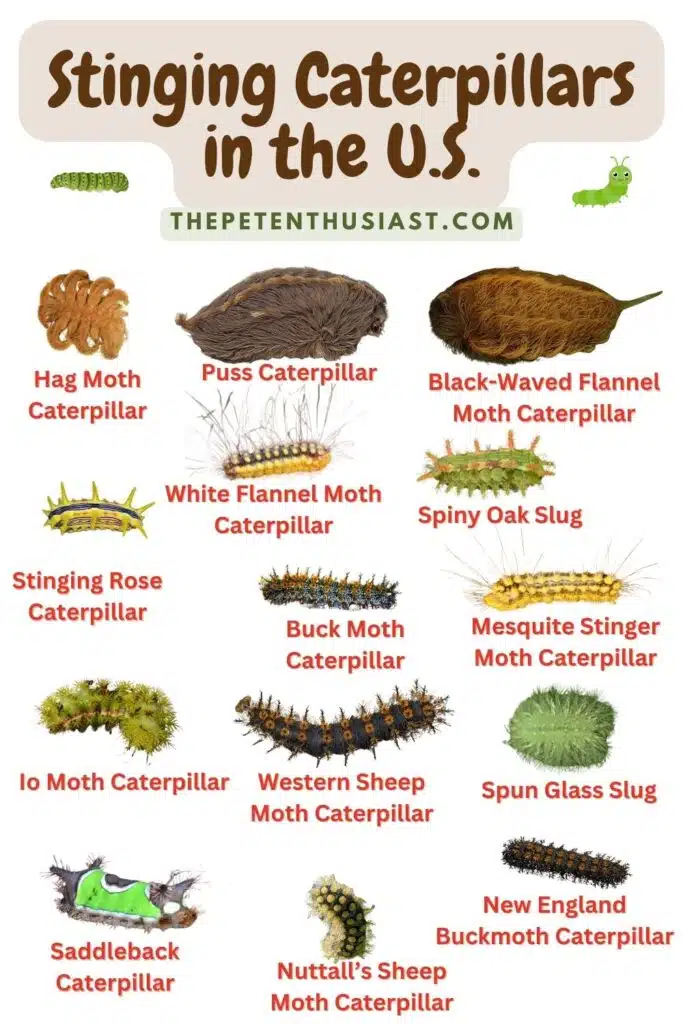
All of the following species of soon-to-be moths or butterflies known as caterpillars can sting.
1. Puss Caterpillar
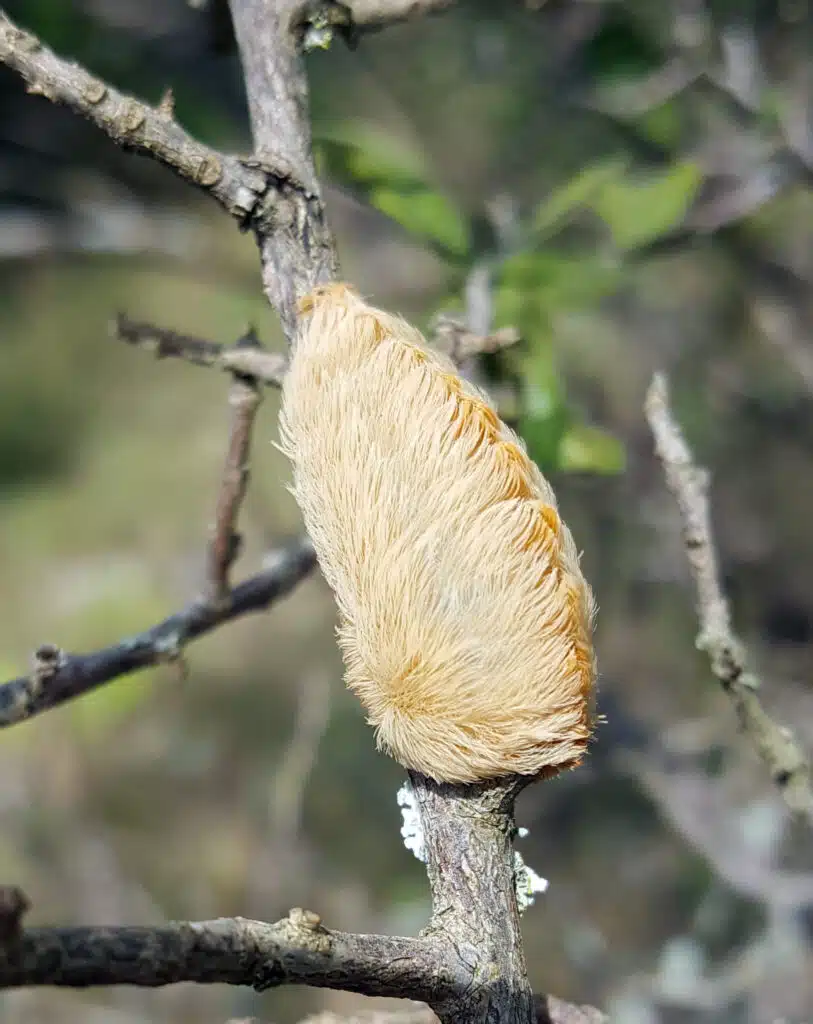
A hairy-looking caterpillar, Puss Caterpillars (Megalopyge opercularis) have one of the most painful stings in the world of caterpillars.
All of these stings happen right next to its host trees, which include oak, maple, or hackberry.
This is where Puss Caterpillars eat and live.
The stings can happen when picked up or if the caterpillars fall on a person under these trees.
Identified by their short tail or body narrowing and the multiple hairs covering the body, Puss Caterpillars are normally brown.
This is a species that can irritate the skin with any of its hairs, but most importantly, with the spines hidden under these hairs.
Stinging Puss Caterpillar spines can trigger lasting pain. It can take up to a few days for pain or skin-level discomfort to fade away after stinging.
The hairs of the caterpillar help protect the spines and may make the caterpillar friendly-looking. However, they hide the poisonous spines and show this caterpillar shouldn’t be handled.
Even more, late instar or larger Puss Caterpillars are even known to trigger higher pain compared to the younger caterpillars with shorter spines.
2. Black-waved Flannel Moth Caterpillar
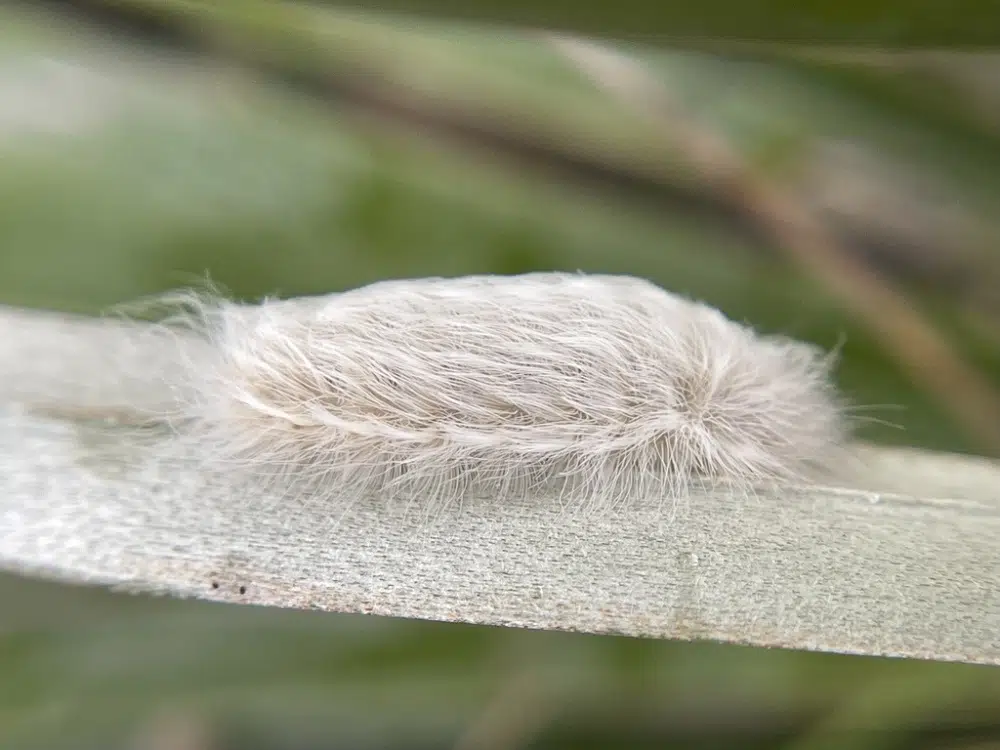
High color variation is specific to Black-waved Flannel Moth Caterpillars (Megalopyge crispata). It can be one of the reasons why people pick it up, confusing it with another species.
Throughout its life stages, this is a caterpillar covered in hair.
In their initial growth stages, these hairs are long, scarce, and white. They can be urticating.
These hairs then become orange and orange-brown, to eventually settle in brown or brown-red nuances in the caterpillar’s mature stages.
They also become shorter and only partly cover the body of the species, forming a band-like grouping on its body, unlike the hairs that completely cover The Puss Caterpillar.
By comparison, even the sting of Black-waved Flannel Moth Caterpillars is considered less painful than the sting of Puss Caterpillars.
As with Puss Caterpillars, most stings happen when these caterpillars are picked up from hardwood trees.
A species highly common in the warmer summer weeks, this caterpillar rarely falls on people under its hosts as its stings happen when they are removed from backyard trees or when handled when out camping.
On its host tree leaves, this caterpillar also looks like a round dome-shaped lump of hair, rather than a type of caterpillar that resembles non-hairy caterpillars.
3. White Flannel Moth Caterpillar
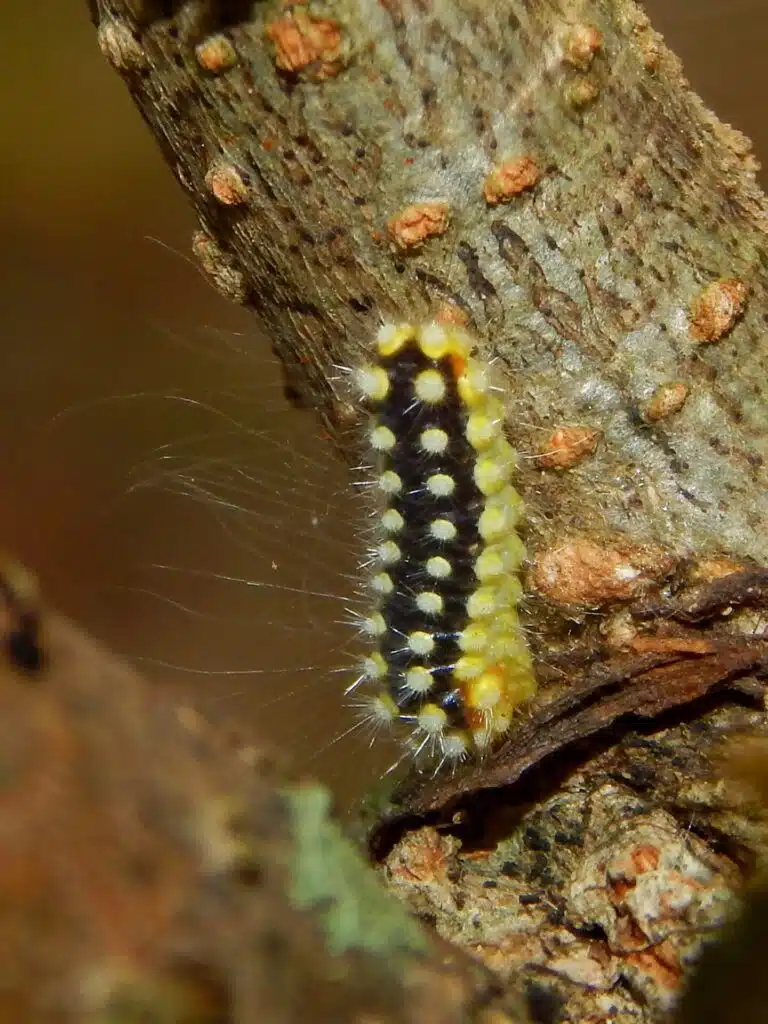
Partially black and partially yellow, The White Flannel Moth Caterpillar (Norape cretata) isn’t actually white but it can sting.
This is the type of caterpillar that may confuse humans into thinking it cannot sting as it only has a few long and soft black hairs.
Soft black hairs on the caterpillars don’t sting.
On the other hand, there are short spiny yellow hairs grouped at the base of the long black hairs which do sting.
Apart from them standing out on the black dorsum of the species, these shorter hairs can sting and even get stuck in the skin.
These are among the hairs often recommended to be removed by tape from the skin.
A species that grows to a size of just over 1 inch, White Flannel Moth Caterpillars are specific to hardwood trees.
Redbud leaves are known to offer food and shelter for these caterpillars.
4. Mesquite Stinger Moth Caterpillar

A species of The Southern US deserts, Mesquite Stinger Moth Caterpillars (Norape tener) are among the few caterpillars that can live in these arid climates.
This is a species mostly associated with mesquite, but it can also thrive on other hosts such as acacia.
Mostly yellow, this caterpillar shows additional black bands along its body.
Long yellow hairs are scarce, but urticating on this species.
These types of hairs cause skin-level irritation. Milder than the stinging sensations triggered by other stinging caterpillars, these hairs can still be problematic.
Mesquite Stinger Moth Caterpillars can trigger an itchy sensation in the area of skin contact.
In turn, this can lead to some complications such as urticaria, aggravated red skin, and itchy skin condition.
It can also lead to cellulitis, an aggravation mostly caused by scratching and dispersing bug-spread bacteria.
In both cases, it can take days plus topical treatments to eliminate the results of direct skin contact.
5. Saddleback Caterpillar
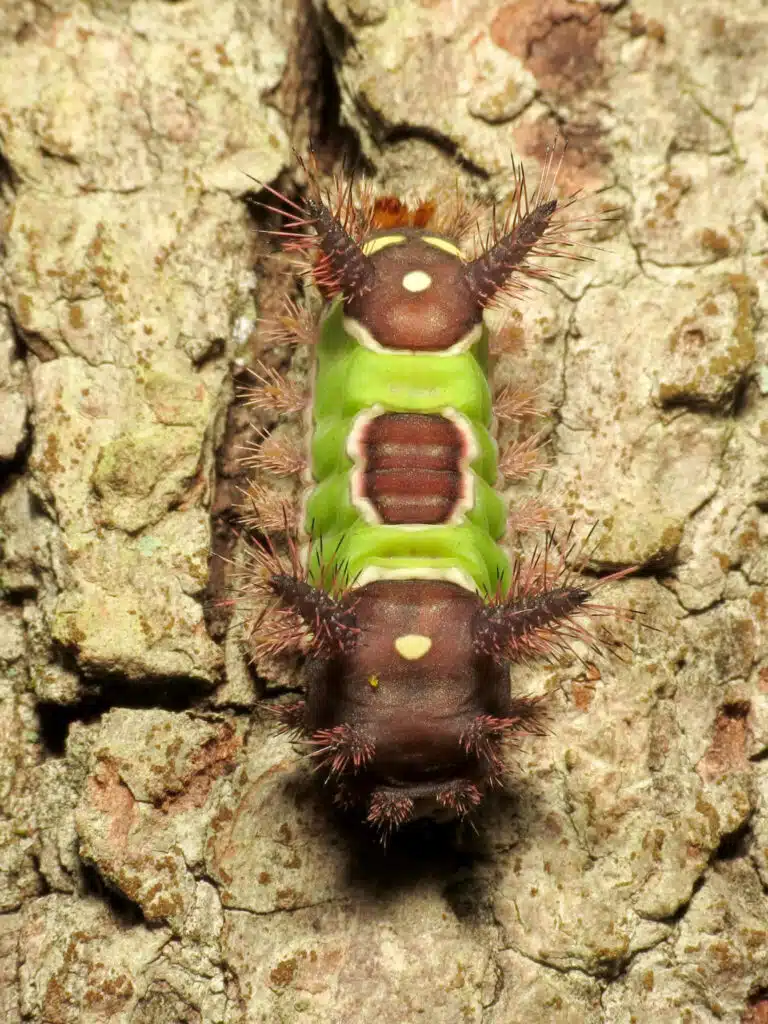
Saddleback Caterpillars (Acharia stimulea) also sting. While they aren’t the most harmful type of stinging caterpillars, they’re more common than other species.
Their commonality is given by a wider range of host plants, including those in the rose family.
As a result, these types of caterpillars can sometimes sting in parks and gardens, not only in remote forests.
Even more, they are often found on plum and pecan, which means they are more common than initially believed.
With small thorns in its early days, this is a caterpillar that can trigger irritation and sting within its first days.
Its thorns become fully-fledged spines with small spikes in its late instar, the period its sting is most likely to pierce deeper into the skin and cause extra irritation.
This is also a species that starts to gather more toxins into its later growth stages as this is when it feeds on the inner side of host tree leaves.
Saddleback Caterpillars use these thorns and spines to add protection against its most common predators but some of them can break upon contact with the skin.
Apart from its first couple of days when it has no spines or thorns, this is a caterpillar that doesn’t have too many predators outside wasps given its spiny appearance and colorful green dorsal saddle.
6. Spiny Oak Slug

Oak, willow, and ash are among the most common hosts of Spiny Oak Slugs (Euclea delphinii).
This is a species known for its preference for the leaves of hardwood trees and it can be found in states such as Florida.
Changing colors at different life stages, The Spiny Oak Slug is mostly green to end up in a uniform green color with green spines.
The sting of this species is neither more painful nor less painful than the sting of other caterpillars as it is believed its reactions are people-specific.
The spines of these caterpillars are covered in small thorns but they may not trigger reactions in some people.
Mild reactions such as rashes are typical for those handling the caterpillar.
Some people even end up in the hospital in case of serious adverse reactions to its sting.
The best approach is not to handle this green caterpillar as skin-level reactions can sometimes expand to other more severe reactions such as pain that doesn’t go away.
7. Hag Moth Caterpillar
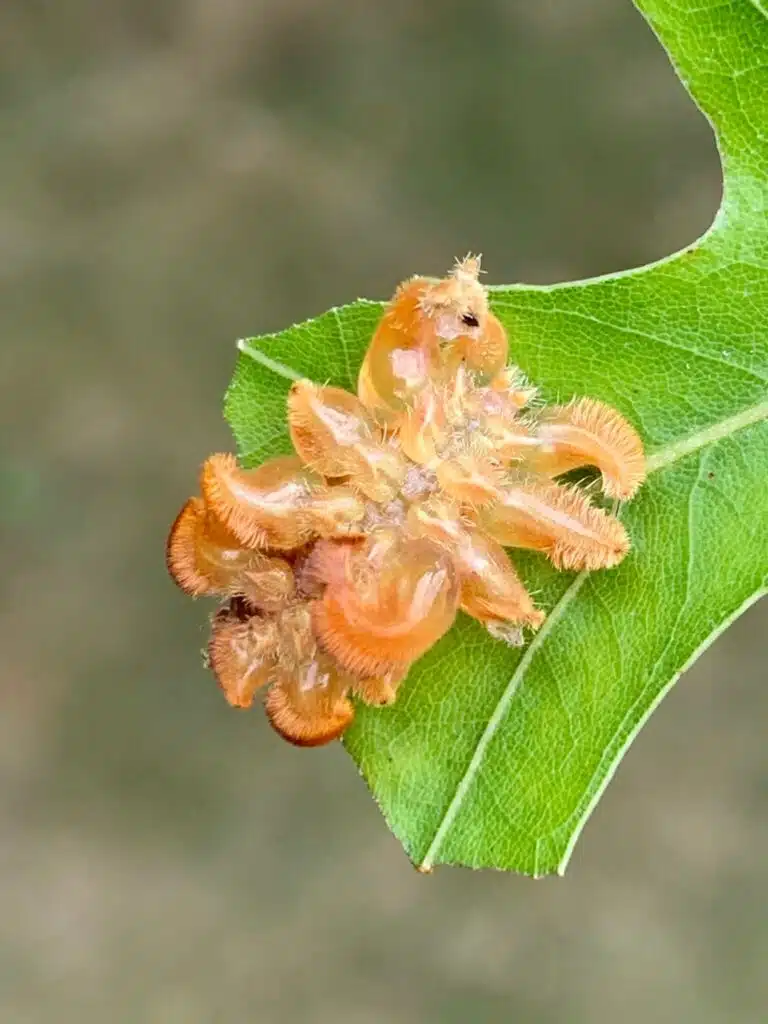
A tentacle-shaped caterpillar, Hag Moth Caterpillar (Phobetron pithecium) has a hairy appearance.
These types of caterpillars are believed to sting, but this isn’t always the case. Scientific literature is split when it comes to its stinging capacity.
Hag Moth Caterpillars can sting as there are reports of a painful sting, red skin, swollen skin, and itchy skin.
These associated symptoms don’t last long, on the other hand.
Unlike most other types of stinging caterpillars, Hag Moth Caterpillars are believed to cause severe adverse reactions.
Common at the end of the summer, Hag Moth Caterpillars look like they have more legs on the sides as tentacles, which makes them easy to avoid.
Tan, brown, and even golden nuances are specific to this species.
Not exclusive to host plants, these caterpillars can sting almost anywhere as they are found in forests and on individual trees such as oak trees.
They feed on the leaves of these trees which they never leave until they turn adult moths.
8. Spun Glass Slug
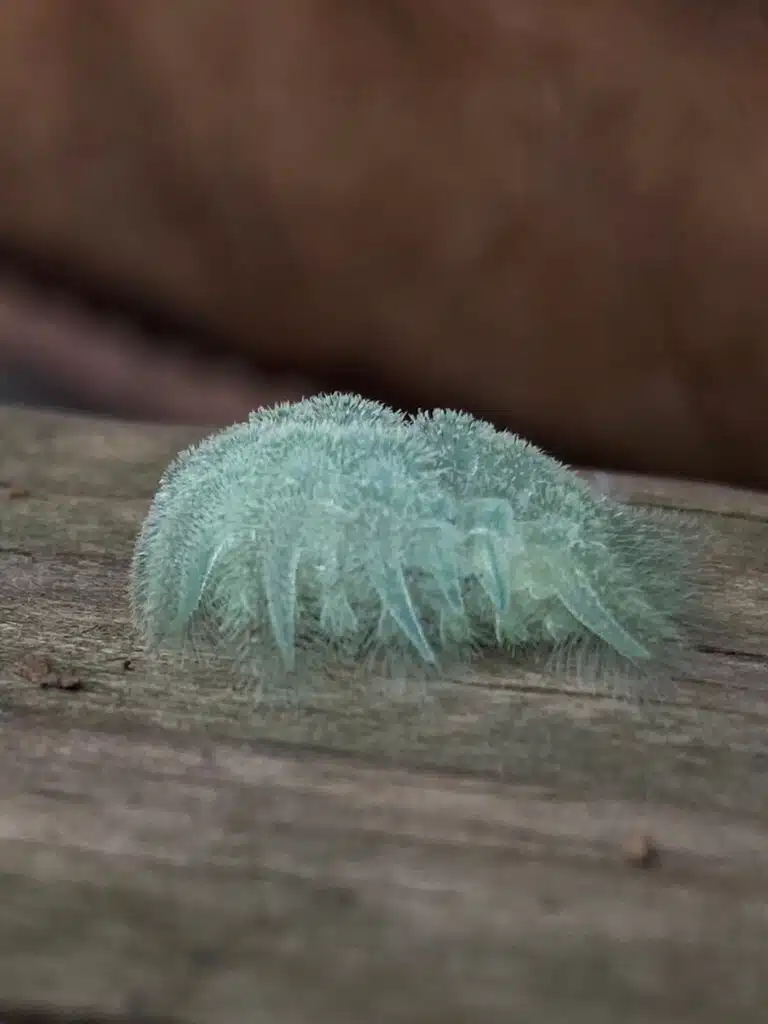
Spun Glass Slugs (Isochaetes beutenmuelleri) are among the atypical-looking caterpillars that can sting.
Some people are tempted to touch these caterpillars as they almost look like another species with their multiple tentacles.
By some reports, this is also a stinging species but its spikes don’t usually break into the skin.
They can cause cutaneous irritation, however.
With a green body, Spun Glass Slugs also have shiny green tentacles with green hairs that make them stand out on almost any other surfaces outside the leaves it lives on.
Since it spends most of its life on green leaves, Spun Glass Slugs are actually difficult to spot.
Oak trees are among the common hosts of the species which can sting anytime during the summer, up until August.
9. Stinging Rose Caterpillar

Yellow spines and tubercles on The Stinging Rose Caterpillar (Parasa indetermina) stand out.
The body of the species is mostly red, orange-red, and black while its yellow spines are bright yellow.
They are venomous spines which means most people touching them can suffer from different types of irritation.
Stinging Rose Caterpillars have multiple spines which release venom upon content. Furthermore, they break off into the skin which means the reactions are typically adverse.
The pain associated with the sting of this caterpillar is as high as it gets compared to the sting of some of the most painful caterpillars.
Stings are common, especially since the caterpillar is a common sight in dense population areas such as New York.
10. Buck Moth Caterpillar

Buck Moth Caterpillars (Hemileuca maia) also have painful stings. These caterpillars have multiple sharp spines with venom glands at the base.
These are hollow spines that conduct the venom to the skin of humans or other mammals and they cause severe skin-level or radiating-type of pain.
Buck Moth Caterpillars are among the species with a mostly dark appearance. Brown and black nuances are specific to the species which has mostly black spines.
These spines aren’t very flexible and they can break in the skin as well.
Found on almost any type of oak. Buck Moth Caterpillars may be a stinging problem when camping or hiking in the summer.
They grow and can sting in their caterpillar stage which can last through the summer as adult Buck Moths only arise in October.
Seen as a forest pest for its risk of defoliation, The Buck Moth Caterpillar is often managed with preventive chemical sprays.
11. Io Moth Caterpillar
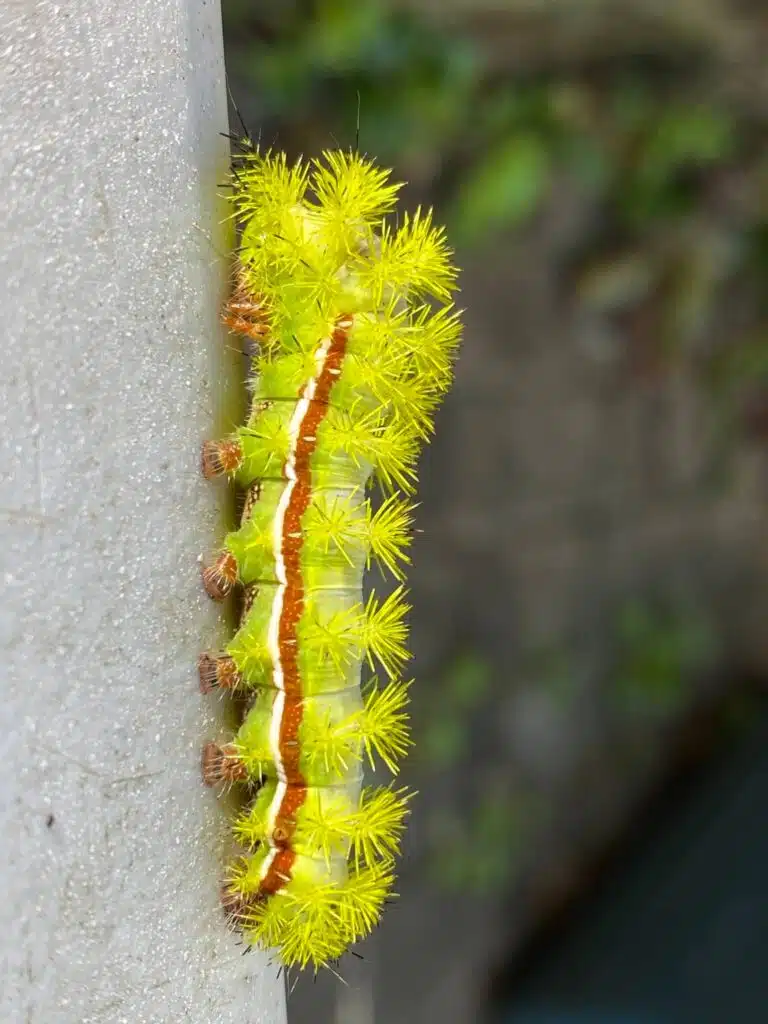
A species that grows into a green caterpillar (from an initial brown color), The Io Moth Caterpillar (Automeris io) is known for its multiple irritating short spines.
These are green or yellow-green spines with a thin profile that immediately break into the skin.
Easy to remove, the spine can cause pain and itching in humans. In some cases, there’s also swollen skin either in the area of direct contact or in an extended area.
All of these symptoms are mild, compared to the sting of other caterpillars, and go away in a few hours or within a day.
As with all stings, some of the reactions can be more severe and require medical attention.
Correctly identifying this species and staying away from it is easy. While green, like most caterpillars, Io Moth Caterpillars have a red lateral stripe that tells predators to stay away.
12. Western Sheep Moth Caterpillar

A species named after the Western North American territories it inhabits, The Western Sheep Moth Caterpillar (Hemileuca eglanterina) is skin-irritating.
Pink-purple at one point of its growth cycle, this moth is covered in short yellow spines which are irritating to the skin.
The risk of getting stung is high in gardens as this is a species with multiple hosts, not just hardwood trees.
It can live with rose, wild rose, and currant, which means they are always at risk of touching it when spending time in the garden, in the forests, or when camping close to mountain lilac.
13. Nuttall’s Sheep Moth Caterpillar

Western and Southwestern US territories are home to Nuttall’s Sheep Moth Caterpillar (Hemileuca nuttalli).
This gray and black species has multiple rows of spines which are covered in small spikes that break off into a soft surface such as the skin upon contact.
The poisonous species causes skin irritation and pain levels that can last for days.
Found on bitterbrush and gooseberry, this is a species that’s also common around juniper woodlands.
Nuttall’s Sheep Moth Caterpillars can be absent from their range at times but abundant in other years.
14. New England Buckmoth Caterpillar

A dark-looking caterpillar, New England Buckmoth Caterpillars (Hemileuca lucina) are mostly found around New England territories.
This is an aggressive species of caterpillars that can even attempt to bite in their first instars.
The spines covering their back are either long or short. Both can trigger allergic reactions when stung.
Some of the times when these types of stings are common are in the caterpillars’ early growth stage as they live in groups.
As they grow, they disperse, moving out on their own but also growing longer spines.
These types of caterpillars may additionally consider different self-defense methods such as regurgitation.
Giant Silkworm – The Most Venomous Caterpillar In The World
Part of the Lonomia family, Giant Silkworm caterpillars are the most venomous in the world.
Mostly found in Brazil, they show atypical stings which result in human deaths each year.
These venomous caterpillars have strong venom which acts as an anticoagulant.
It can affect kidneys and kill humans within days.
However, a single Giant Silkworm caterpillar may not have sufficient venom to kill humans. It’s when multiple caterpillars are touched, typically by accident, that deaths happen.
This is a type of conspicuous caterpillar taking on the color of tree bark so that it may not be easily spotted.
Even more, it tends to live in groups, which means people may lean against these caterpillars on barks when taking a break from hiking or when seeking shelter from the rain under a tree when out hiking.
Touching tree bark can lead to touching multiple Giant Silkworm caterpillars which can be problematic for some people facing death.
Internal hemorrhages caused by the venom of multiple Gian Silkworm stings need immediate medical attention.
First Aid For Stings
Most caterpillar stings should be taken seriously and the area should be washed, as a bare minimum. Here’s what to do if you’ve been stung.
Remove the hairs or spikes stuck in the skin
Most caterpillars stick their coarse hairs or spikes into the skin where they break off and release poison.
This requires immediate attention, despite the pain which can be high.
You need to remove these hairs or spines from the skin. This can be done using your fingers, for long hairs that can be plucked out easily.
Using tape is another proven method for multiple hairs or spines stuck in the skin.
You may not be able to remove them all on the first attempt. Make sure to use a fresh tape section for each attempt to remove the hairs from the skin as quickly as possible.
Wash the stung area
You can wash the skin after all of the caterpillar’s hairs and spines have been removed.
This can be done with soap and cold water. Focusing on the stung area is important.
Fresh cold water is best as it also has a cooling effect which may help reduce itching sensations or acute pain which isn’t unheard of in the world of caterpillar stings.
Ice packs help reduce pain
Applying ice packs helps reduce pain, inflammation, and swollen skin symptoms.
Ice packs may need to be re-applied multiple times per day as caterpillars often cause pain and swelling that lasts up to a week, as seen with some of the species listed above.
Ice packs should only be applied on washed stung areas as it’s important to prevent infections first.
Baking soda reduces itching sensations
In some cases, ice packs alone may not be sufficient to mitigate pain, rashes, or swollen skin.
Among all of the homemade remedies, it turns out baking soda helps out the most with reducing itching sensations.
These are typical sensations that may infect the skin if left unmanaged.
You can mix baking soda and water and apply the mixture to the area of the skin that itches the most.
The mixture needs to be washed away after a few minutes.
Topical hydrocortisone and antihistamine creams
Some over-the-counter solutions can also help with itching and red skin following caterpillar stings.
The first option is to ask for hydrocortisone creams. If it doesn’t work, you can ask for antihistamines, but even these solutions may have no effects in some cases.
Seeking medical attention
More serious reactions to caterpillar stings require immediate medical attention.
Weakness, nausea, difficulty breathing, or an infection are among the typical severe reactions that prompt a visit to the nearest hospital.
While rare, these types of severe reactions are documented by studies. Children may be particularly vulnerable both to getting stung and suffering from more severe reactions.
Prevention and Control
Keeping caterpillars away is almost impossible in some areas such as forests, parks, or even gardens.
A smaller space such as a backyard may be controlled, on the other hand. There are at least a few proven methods to keep caterpillars out.
Use safety gloves to remove caterpillars from plants in the garden
Almost any type of gardening gloves is better than gardening without gloves.
Safety gloves such as those made with thick natural leather might be a good choice when gardening or when clearing different types of caterpillars from your household plants or backyard trees.
Even better, you may use a stick or another object to get them off the leaves they live on and into a container.
Consider insecticides
Some types of insecticides are particularly useful for caterpillars. You may want to consider calling in a professional to spray the backyard with insecticide.
The summer months mark the advent of most stinging caterpillar invasions. If you have an oak tree or willows on your property, it’s time to consider insecticides as these are some of the preferred hosts of caterpillars.
Buy parasitic wasps
Some types of wasps lay eggs directly on caterpillars. Paper wasps and other types of wasps are known for being parasites of caterpillars.
Different wasps can be ordered online. They may be useful in controlling caterpillar outbreaks.
On the other hand, preventive measures also include camping in clear areas, inspecting camping locations, and checking out the trees you rest under as many stings happen away from home.